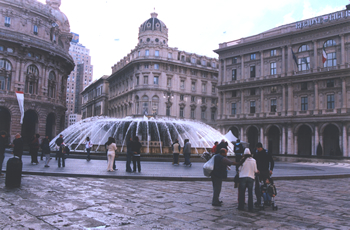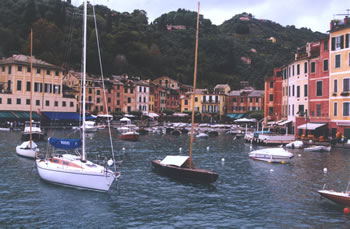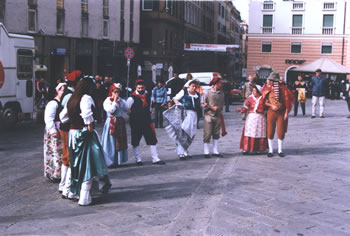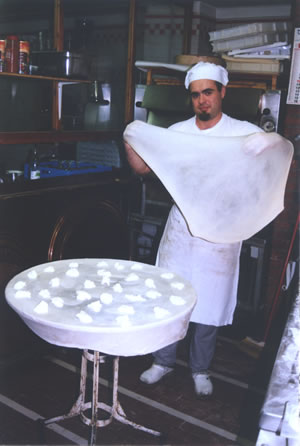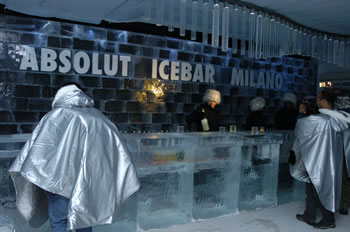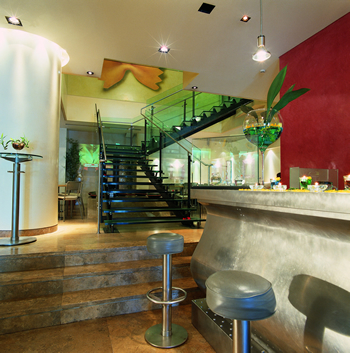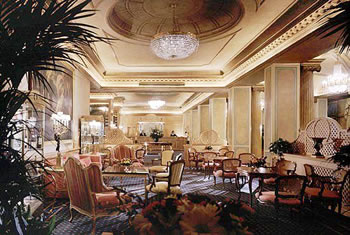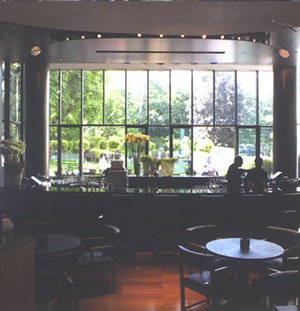 |
|
|
|
|
|
|
|
|
|
|
|
|
|
|
|
|
|
|
|
|
|
|
|
|
|
|
 |
 |
|
|
|
|
|
|
|
|
|
|
|
|

|
Genoa and Milan, Italy Capital of Culture 2004 and Center of Chic As one of the most important ports on the continent, Genoa historically has been a veritable gateway linking southern Europe to the world. A 19th-century poet was said to have written that Genoa looks like a snake that swallowed a rabbit. A 30-km. long strip of land within city boundaries stretches from central Genoa along the Ligurian coast. Some believe that the name Genoa derives from Genua, founded by the two-headed Giano, protector of ships and coins. Latin scholars attribute Genoa"s name to the word "janua” whose translation is "door.” The port is in another way a gate, tempting its residents to escape from the limitations on expansion by the steep slopes of the Apennines and the rocky soil yielding sparse crops.
The restless Genovese pressed out to sea and returned with riches, which enabled them to build grand palaces and collect masterpieces by Caravaggio, Van Dyck and Rubens. Genoa knew two glorious eras, the 16th century when the aristocracy reigned and the 19th century, which saw the rise of the bourgeoisie and of neo- classicism. As the glory of those days dwindled so did the city"s fortunes. The waterfront grew shabby and as mentioned in some guide books even threatening. In the past dozen years the city that once was known as La Superba (literally the proud) staged a comeback. Travelers who write off Genoa are doing themselves a disservice. The city is eminently civilized and walkable, comfortable to visit, non-touristy, and has many fascinating attractions, among them the old quarter with its narrow carrugi (streets). The late 20th and early 21st century renaissance can be attributed to one man and two events. In 1992 to celebrate the 500th anniversary of Columbus"s journey to America, Genoa hosted the World Expo. Renzo Piano, the renowned and forward-thinking Genoese architect, redesigned the waterfront. Unlike many fairs whose structures are temporary, the portside attractions were not demolished. Named as a European City of Culture for the year 2004, an honor for which the city lobbied hard, the face lift continued. We interviewed Paola Casabulo, an official with the tourism division of the Commune de Genova, who said the money that was invested in "restyling” the city not only increased tourism, but that the changes that were made are being enjoyed by the citizenry. She added that Genoa whose slogan is "A City that Will Surprise You” will keep on surprising as the metropolis is still "a work in progress.” The spirit has changed, too. The medieval section is lively at night. Young people have been encouraged to open shops and bars bringing prosperity to the area. An international summer festival of poetry, music and ballet that began in "04 will continue annually. What remains of the commercial section of Porto Antico will be moved and an open-air theater, galleries and restaurants are expected to be operating by 2008.
Already in place is the largest aquarium in Europe, completed in 1992 for the Expo. Home to sharks, dolphins, penguins and some 500 other species, this museum of "the history of exploring nature and naturalism” has features not found elsewhere. Most unique is the reproduction of Tsingy rain forest in Madagascar. The vegetation creeps up a wall, a river runs through and in a section of the coral reef, there"s a touch tank. The symbol of the 1992 Expo, Il Bigo, an Italian naval term for derrick, is just south of the aquarium. The waterfront crane hoists a revolving cabin into the air allowing its occupants a full-circle view that sweeps from the sea to the hills. Galata, a Museum of the Sea and Navigation, was rebuilt from an old arsenal for the 2004 celebration of the European Capital of Culture and highlights the city"s role in exploration and discovery. Galata will remain a permanent fixture on the landscape. Two floors are devoted to the maritime history of Genoa. On display are boats, including a 17th-century galley, equipment used on ships, nautical paintings and information about the town"s most famous sailors, Christopher Columbus and Andrea Doria. The remaining space is given over to an observatory and to rotating exhibits, such as "Transatlantic Ocean Liners,” designed with so much interactive technology that visitors felt they were onboard a ship. The restoration of the Genoa Wolfson Museum, the "Gallery of Modern Art” in Nervi, was not completed in time for 2004, but will finally open next year. Some important Italian and European paintings from Miami-based Micki Wolfson"s collection will be on display. Multiple exhibits on biotech, telephone, electricity and hang gliding were scattered throughout the city during the second International Science Festival, which took place in October and November. The event was so successful that it will be held annually just like the October International Boat Show, now in its 44th year. Not only has the waterfront been spruced up, but the center is a remarkable example of urban renewal to make the old town "beautiful, cultured, new.” For a view of the entire panorama, the city and the old and new ports, take the funicular railway to the last stop, Righi. From the hills you can see the forts that ring the city as well as all the way to the end of the Ligurian province. The true heart of Genoa is the Palazzo Ducale and the nearby fountain in the adjacent Piazza de Ferarri. The facades of the villas and palaces that were built on Via Garibaldi, the town"s grandest street, by noble families in the late 16th century were freshened up for 2004. The palaces" occupants owned valuable art collections. Palazzos Rosso and Bianco belonging to the Brignola Sale family were linked with Pinola and Reale into a network of museums dedicated to showcasing the art that was acquired by the Genovese nobility. The Church of Jesus Christ where two Rubens paintings hang was built in baroque style by a titled family for its own private use.
It is a delight to walk the old carrugi and piazzas and to look up at the Cattedrale di San Lorenzo built with slate and marble horizontal bands, the 13th century Gothic churches, the fading frescoes and the pink and yellow buildings. And it is pleasing to watch the lively street life—a wedding party gossiping in front of Town Hall (Palazzo Tursi), a troupe of dancers in provincial costumes, groups of musicians and street vendors roasting chestnuts for an autumn celebration.
Excursions from Genoa For a day trip to Portofino, the Italian Riviera"s (Riviera di Ponente) most glamorous town, we drove the Via Aurelio to Rapallo and caught the ferry. The walkway bordering the water was filled with visitors enjoying a three-day holiday weekend and at the string of hotels overlooking the sea business was brisk. Up the hill on the main street the open-air market, shops and cafes were crowded with customers. In Portofino the harbor is filled with boats at rest and the main street hosts stores selling the world"s best known luxury goods. Steep woods with stairs and a road weaving to the top is the backdrop to the small port. The climb up the hill to the Hotel Splendido, where you might pause for liquid refreshment, is not too strenuous. The Cinque Terre, five ancient villages whose beauty is fabled, is strung out on rocky cliffs amid terraced vineyards and other Mediterranean vegetation. The most convenient way to get to/from and between them is by train. Cars are not permitted inside the communities necessitating a hike of up to 1 km. at each stop. The longest distance between towns is 7 km. with the most famous coastal path between Riomaggiore and Manarola being a mere 1 km. It is said to be the most romantic of the routes. Perhaps because it is the shortest one, it gets more traffic and, hence, more publicity. Ligurian Food
Ingredients from the sea—bream and anchovies—and from the surrounding hills—mushrooms, fresh herbs, olive oil—form the backbone of Genoese (and by extension Ligurian) cooking. Pesto, foccacia and antico pandolce head the list of dishes for which the area is famous. Driving back from Portofino we stopped at an attractive trattoria in Recco, da o Vittoria, where the meal might be described as a taste of everything Ligurian. One local specialty, foccacia with formaggio, was made from paper thin dough stuffed with Canadian Manitoba cheese, a cross between feta and mozzarella, and fired in a wood oven. Large square noodles were tossed with pesto. Mushrooms were prepared three ways: slivers of ovuli (small eggs) in an olive oil, lemon and Parmigiano dressing; in ravioli; and in a combination of herb-stuffed anchovies, calamari and portobellos cut like flowers. Zeffirino, Genoa"s illustrious and most expensive restaurant, serves its creamy cheesy version of pesto over lasagna, too. Frank Sinatra so enjoyed this sauce that he had it shipped to the States regularly. The best mushrooms we"ve ever eaten were the shitakes in a veal dish. Along with orata, a local fish, they had that special Ligurian flavor. Regional wines are as good as the food. We frequently drank Vermentino, a delicate and smooth white that complemented every dish. At Villa di Profumo, paticceria confetteria, a fine pastry and candy shop, Genoa"s signature sweet, antico pandolce, is available in several sizes. The dense texture of the rich cake is much like that of a scone, but it is sweeter, buttery and studded with candied orange peel, black and golden raisins and pine nuts. Where to Stay Genoa has no five-star hotels. We investigated four of the 4-star hotels. The newest, Jolly Hotel Marina, is located at the port. The medium-sized rooms are bright and clean, but the Jolly is very definitely a motel. Bristol Palace, the hotel with the most cache, was a former 19th-century mansion with an oval-shaped spiral staircase that winds up to a stained glass ceiling. The rooms are very large and furnished with formal heavy furniture. Amenities—dry cleaning, fitness center, restaurant except for breakfast--are lacking. The 10-room boutique property Locanda Di Palazzo Cicalo, a reconverted ancient building, has the best location, just in front of the cathedral. Guestrooms with individual internet access are enormous and outfitted with modern furnishings. All but one room has showers rather than tubs. We slept at Hotel Savoia Majestic near the train station and not far from the historic center. Our room was in the attached Continental. The hotel offered to change it when we complained about the lack of a tub, but the time they suggested for moving was not convenient. The well-trained staff was most helpful and the buffet breakfast was fine. But because of the smallish size and odd shape—it was almost triangular—of our room, the hotel rates just three stars. da o Vittorio, via Roma, 160, Recco. Tel. 0185-74029. Zeffirino, Via XX Settembre, 20 Genova. Tel. 39010.59.19.90. Villa di Profumo, Via Del Portello, 2R, 16124 Genova. Tel. 010.2770002 Jolly Hotel Marina, Molo Ponte Calvi. Genova. Tel. 010 2 53 91. http://www.jollyhotels.it/ita/ALBERGHI scheda classic.asp?Obj=1163 Bristol Palace, Via XX Settembre 35, Genova. Tel. 01059 25 41. Locanda Di Palazza Cicala, Piazza San Lorenzo 16, 16123, Genova. Tel. 39 010 251 8824 Hotel Savoia Majestic, Piazza Stazione Principe, Genova. Tel. 010 26 16 41 An excellent guide is Andrea Azzinari, tel. 0039-010-1753263, 0039-339-1753263, zuggino@yahoo.com. He suggested four new bars, none of which we visited, which he said were quiet and cozy. They are Bistrot Hop Altrove, Piazza Cambiaso; Nouvelle Vague, Vico Gradi; Café Garibaldi, Via 4 Canti di San Francesco; Café/Library, Piazza Santa Crocie . Milan, Center of Chic Milan is cool, way cool. Everyone knows that major trends in fashion, design and lifestyle often begin here. Take its vibrant bar scene beginning at 6:00 and ending when the last guest goes home. It"s de rigueur to go out on the town every night. In many bars, the price of a beer, drink or wine, often just six to eight euros, also buys a buffet that doubles as a delectable dinner and guarantees patrons will be fed as they socialize.
At the town"s newest tavern, Ice Bar, the temperature registers 27 degrees Fahrenheit, but on the chic meter it breaks the ceiling. We learned of its opening just 10 days before we were to be in Milan and it was the first place we hit after checking in. The bar in Piazza Gerusalemme is equipped with a large ice lens visible from any spot in the square. The blue glow emanating from inside shines through the front window and acts as a beacon guiding patrons toward the door. Not only don"t you check your outer clothing at this drinking hole, but you are provided with more of it--a hooded silver poncho, gloves and boots. Walls, tables, a sofa, a long bar, a hanging bar counter and chandelier are all carved from ice. Because the cold in the bar is a dry one, we felt no discomfort and could easily have stayed longer than the 30-minute limit. V & S Absolut spirits of Ahus, Sweden is a partner in the project. The drinks are based on its flavored vodkas. Expect to find currant, lemon, pepper and raspberry cocktails served in square glasses carved from ice. To build the bar, which has to be remade every six months, 50 tons of special ice was hauled from the Sweden"s Tome River, 125 miles north of the Arctic Circle. The purity of the river"s water is what makes the ice so transparent. After the maximum stint in the Ice Bar located on the street level of the new Townhouse 12 Hotel you can expand the evening with a visit to the second floor THerrace 12 for another drink and a copious buffet. In keeping with the property"s theme, reindeer meat prepared three different ways is served. Where to Stay UNA Hotel Tocq, located in the fashionable Corso Como section where many young people hang out at night, caters to both leisure and business travelers. Built 14 years ago and refurbished in 1999, its design is very contemporary. The hotel is part of the rapidly expanding Italian UNA Hotels and Resorts. A modest sign "Amgen” at the sleek front desk was the only hint that a conference was going on. Six cheery and colorful meeting rooms are relegated to the downstairs floor.
Oak wood, stainless steel, Plexiglas, glass and arc-shaped curves contribute to a modish look especially in the bar, the most outstanding design feature in the building. Empty decorative frames hanging on the walls of the room make an unusually eye-catching display. The action in the bar is the same as at any hip hotel. At lunchtime a buffet lunch and a few hot dishes are served. At night a spread of tasty bar foods are offered for the price of a drink. The restaurant, a pleasant space, can be accessed from a dramatic staircase. A very attractive terrace several times the size of the restaurant adjoins it. The restaurant seems mostly to attract Our ultra-large and comfortable room and oversized bathroom offered every amenity. UNA Hotel Tocq, Via A. de Tocqueville, 7/D, 20154 Milano. Tel. 39 02 62 07 1 The Westin Palace Milan The Luxury Collection is the top brand among the six divisions of Starwood Hotels & Resorts. Of its 13 properties in Italy, most, like the Westin Palace, were reconstructed from centuries-old palaces. The modern exterior belies the sumptuous classic interior. The large lobby holds many nooks where guests can socialize or read. The Lounge, the hotel"s newest bar, has its own version of Milan"s happy hour. To accompany drinks individual "Lollypop trays” filled with creative hors d"oeuvres are brought to the table.
The Heavenly Bed, a concept that originated in the United States has spread to 17 hotels in Europe. The all white bed is made up with a pillow-topped mattress set, three fine cotton sheets, a down blanket, a comforter, a duvet, and two king, two queen and one bolster pillow filled with goose down and feathers. Without a doubt these pillows were the most comfortable we"ve ever slept on and the bed was indeed heavenly. Our sprawling deluxe double high-ceilinged room was the size of a suite. It was done in Empire style with a crystal chandelier, a heavy dose of gold paneling and was worthy of the designation "Luxury.” The marble bathroom with grand dimensions had two sinks and a double headed "Heavenly Shower.” Good Morning Elegance, the Luxury Collection"s newest program in Italy, partners with the Ermenegildo Zegna. Depending on the length of stay and choice of accommodations, guests receive a credit toward a purchase at one of the clothing designer"s boutiques We were surprised at the careless turn-down service one evening. The housekeeper had neglected to remove a plate of fruit peels and to refill the tissue box. The front desk staff was very helpful, with the concierge ready with answers to our many questions and volunteering valuable information. We were told that if you haven"t reserved sufficiently in advance (a necessity) to get in to see Da Vinci"s Last Supper at the Church and Convent of Santa Maria delle Grazie, book a half-day sightseeing tour that includes entry to the church. To reserve on your own try http://www.cenacolovinciano.it or 02.89421146. Westin Palace Milan, Piazza Della Republica 20, 20124. Tel. 39 02 6336 3640-1 Where to Dine In a large city, a few short blocks can make a difference. Two quick lefts beyond the intersection of Via Manzini and Via Montenapoleone, Milan"s spirited high-fashion street, in the Via Privata Fratelli Gabba, the ambiance flips from charged to tranquil. Looking much like an Italian-style Country House Hotel, the street"s sole occupant, the Bulgari, is hidden in a large garden, its boundaries further extended by its placement next to the Botanical Gardens. But unlike most country houses the hotel celebrates tomorrow rather than today.
Bulgari in Milan is the first hospitality venture between the prestigious jewelry company and the Ritz-Carlton Corporation. As soon as the hotel opened an international crowd came flooding through the door and headed straight to the lounge, which is presently the "happening” place in town. Attilio Marro, General Manager, showed us around and said that one architectural firm created the building, furnishings, accessories and fabrics. Black, brown and white are the only colors they used. To make all guests feel comfortable, whether they are in jeans or dressed to the nines, the staff wears unstructured uniforms. We looked at one of the inviting guestrooms with its dazzling black matte bathroom as well as the spa and pool lined with golden tiles. Mr. Marro also mentioned that the garden created with four terraced areas drew several hundred people each summer evening. The carefully chosen trees, shrubs and flowers create an unexpected bucolic atmosphere, unusual for the center of any city. Mainly we visited the hotel to eat in the restaurant, an elevated half-moon shaped room overlooking the circular bar lined with exotic plants and the gardens beyond. Most of the patrons wore black and many spoke languages other than English and Italian. Dinner began with an innovative amuse bouche of tasty grilled sardine bruschetta. "Acqua pazza” spaghetti won our applause as it was well executed with fresh seafood, chunks of fish and olives all bound together with a properly spicy tomato sauce. Every grain of rice that swam in a splendid creamy lemon, vanilla flower and herb-based risotto had a velvety texture. Honey and chili pepper roasted baby pig was toothsome. The fat was rendered from the delicate crisp skin leaving it greaseless. In this modern and light rendition of a classic dish, the skin was was served separately from the succulent fork-tender flesh. The crudities and yogurt dip that accompanied the entree may have been served to get the attention of the calorie-counting public, but they were not a good choice to complement the meat. An apple tart dessert with raisins, marrons glace and chestnut ice cream was prepared with sponge cake rather than crust, but was just as satisfying. Our server suggested a merlot, Castelo de la Regene 2001, and we were pleased with the choice. The meal was well-paced. Bulgari"s restaurant is an excellent example of dinner as theater. The restrooms, down a flight of stairs and off a confusing corridor were not easy to find. Perhaps that is why a staff member who escorted us offered to wait. Signs pointing the way there and to the exit are needed. Bulgari Hotel, Via Privata Fratelli Gabba 7b, 20121, Milano. Tel. 39 02 805805 1, http://www.bulgarihotels.com Attractions Everyone who visits Milan for the first time soon discovers that some of the must-see sites are the duomo, Museo Teatrale alla Scala and the Galleria Vittorio Emanuele II. Lesser known, but of equal worth is the Museo Poldi Pezzoli. Think New York"s Frick Museum. Housed in what was once a private residence, the museum"s treasures were assembled by Gian Giacomo Poldi Pezzoli in the 19th century. Many of the oils are masterpieces attributed to Botticelli, Tiepolo and Bellini. The variety of high-quality collections—jewels, time pieces, glass, bronze, porcelain, arms, tapestries, lace and furniture—makes this museum unusual. Museo Poldi Pezzoli, Via Manzoni 12, 20121 Milan. Tel. 02-796334/794889. Winter, 2004-05 |
||||||||||||||||||
